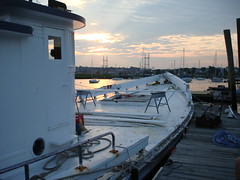Thursday, August 09, 2007
Monday, August 06, 2007
A Day at the Beach and Other Observations
Hammonassett State Park was mobbed yesterday, which isn’t surprising considering it was one of the most beautiful days of the year. What was surprising to me and my wife, Gina, though were the number of different languages being spoken and the number of different ethnicities in evidence. We agreed that there was easily more non-English being spoken than there was English.
The only parking area open when we arrived, about 2 p.m., was on the west end. Indians – or perhaps Pakistanis – had staked out the pavilions and the tree-shaded areas near the parking lot, and women in sarongs were cooking over gas grills. On the beach we heard four or five European languages. There were Africans, and a family speaking Chinese, and Spanish, of course. Near the dunes was a woman in a flowing silk sarong, and down the beach we could see two women in what I imagine were Islamic abayas or burqas. After an hour or so of sitting and reading under an umbrella, I got up and asked the people next to us – two young men and two young women – what language they were speaking.
“Albanian,” they all answered together.
“I was going to guess Croatian,” I said.
“Close enough,” one of the women said.
My son, who is 9, went into the water when we arrived and essentially stayed there, diving for rocks or skim-boarding on the edge – until we left, a bit before 7. I went in twice, Gina once, and my daughter, who is 14 and who requires great feats of persuasion to go anywhere with us, read and walked and skimboarded. The water was pleasantly cool and murky, there were no jellyfish – which can be a problem at Hammonasset – and by 4:30 or 5 the crowd began to thin out. It was almost a perfect afternoon at the beach.
That's what it was like there. What is it like elsewhere on Long Island Sound? The Connecticut DEP says hypoxia in the western half of the Sound looks as if it’s going to be a bit worse than usual:
The 2007 August Water Quality Survey was conducted 30 July through 1 August. Forty-one stations were sampled. Bottom water dissolved oxygen concentrations fell below 3.5 mg/L at 25 stations. Last year 26 stations had concentrations less than 3.5 mg/L. The lowest concentration was observed at Station A4 (1.6 mg/L). This is approximately 1 mg/L higher than the concentration documented last year at A4. The area estimated with dissolved oxygen levels below 4.8 mg/L is 1480 square kilometers while 916.6 square kilometers were below 3.5 mg/L. Data to date suggest the hypoxia extent and duration will be above average.
Here are a few stories from over the weekend:
Oysters and nitrogen removal (an idea that’s hard not to like).
Lobsterman and the v-notch program.
I have a lot of thoughts about this last story – that is, about
Unfortunately, this realization has sapped my enthusiasm for blogging about the Sound. For that and other reasons, I’m taking a vacation from blogging until after Labor Day at least. I’ll be at the beach for two of those weeks anyway. I’ll see what happens when I get back.
And of course is something big happens between now and my vacation that I feel the need to mouth off about, all bets are off.
Wednesday, August 01, 2007
Broadwater's $14.8 Billion in Energy Savings Versus Long Island Sound's $55 Billion for the Local Economy: Which Do You Choose?
And now we also know, from LIPA's report on the economics of Broadwater's proposed LNG terminal, that if its built in the middle of the Sound it was reduce energy costs by $14,8 billion over 10 years (a report that was released, as Bryan Brown pointed out, "only 18 months later than they said it would be available.") LIPA's press release explains it this way:
- Expressed in current dollars, the total economic value of the project in terms of reduced energy costs could be $14.8 billion over 10 years.
- Of that $14.8 billion, New York City energy users could derive $6.3 billion in benefits; energy consumers in the rest of New York could see $5.8 billion in savings; and Long Island’s natural gas and electric consumers could get only $2.7 billion in benefits.
How's that for a trade-off?
Labels: Broadwater



